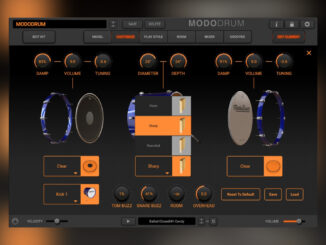Aodyo Instruments Anyma Phi 1.3 is the final update for its physical modeling hardware synth with new oscillator types, and more.
The last day of Aodyo Instruments’ operations has arrived. All operations will cease today, November 1st.
But they close their operation with a final update for the Anyma Phi physical modeling synthesizer. Update 1.3 is out now and brings major new features.
Aodyo Instruments Anyma Phi 1.3
The Anyma Phi 1.3 firmware is the last and final update for its desktop physical modeling Synthesizer—a surprising update for the synth.
It adds four new physical modeling oscillator models: Bass Brass, Flute, Pocket Sax, and Cylysax. Plus, it offers new oscillator models based on the Sylphyo wind instrument: Bagpipe, Corroboree, and Overdrive guitar. This gives you, in total, seven new oscillator models.
The developers then added a detuning parameter to the Artin X3 oscillator, and they raised the drawbar organ’s range by one upper octave. They also increased the range of the pitch-bend range setting.
The Aodyo Instruments Anyma Phi 1.3 update also includes a new slew envelope modulator and an option to make the velocity envelope hard set when a new note is played. The editor’s user interface now also has a scaling option.
Further, they replaced the patch TUN.MOD parameter with a new polyphony mode parameter, only effective with Anyma V. As a bonus, you can explore new patches in the factory bank by Dan Maurer. Thanks for this last feature update.
The new Anyma Phi 1.3 update is available now as a free download on the website’s forum.
Article From February 4, 2024
Often written about, now in my hands. The Anyma Phi landed in a studio for testing and incorporation in upcoming pedal demos. Aodyo Instruments kindly sent one over. It’s a unique desktop Synthesizer, designed and made in France based on my favorite synthesis. It’s not analog but physical modeling. One that you rarely see in hardware.
Anyma Phi is monophonic, a downer, but is at least playable paraphonic. The upcoming Anyma Omega, supported in 2022, will be fully polyphonic and multi-timbral.
Like the big one, the Phi is based on a colorful bouquet of algorithms. 52 algorithms cover many synthesis types: physical modeling, virtual analog, FM, noise, and more.
Besides this, it hosts five effects slots with over 30 types of effects (resonators, granular, …), 16 modulator slots with various classic and advanced modulation sources (LFOs, sequencers, physical and algorithmic processors…), and more.
Aodyo Anyma Phi Sound Demo
The Anyma Phi only comes with +/- 60 sounds from the factory. It’s quite thin if you compare it with the near-endless options of the synth. I would be happy if Aodyo would offer more factory content here in the near future.
Other synths are overflowing with presets, here is more of an appetizer of what is possible with the engine.
I went straight to the Anyma Phi and made a sound demo for you. It was important to me to tweak parameters and see what was possible and how much the sounds could bend them.
I noticed immediately that the hardware can be easily tweaked with the Blofeld-style matrix. However, if you want to go deeper, you can’t ignore the free editor. It reveals the complete engine with its tons of creative features. Difficult to represent everything it offers on the hardware interface.
I’m excited to see where Anyma Phi takes me. How often do I use it in setups, pedal demos, etc? Stay tuned.
Aodyo Anyma Phi is available now for 479€ (silver) and 499€ (black edition)
More information here: Aodyo Instruments
Available at my partner






don’t care. want OMEGA!
Nah, you don’t. There’s no affiliate link for Anyma Ω.
😉
any vst sounding that good?
My favorite VST with physical modeling are: Objekt in Reason Studio Rack Plugin, AAS Chromaphone 3, and Plasmonic (from ex Absynth developer).
The Arturia mini freak is worth a look. The Anyma has a lot of Mutable Instruments models, as does the mini freak.
but just a mini part of it. Anyma Phi has primarily custom physical modeling algorithms 🙂 The MI algorithms are great add-on on these 🙂
I thought the modal module was the strongest module in the Anyma, and the mini freak also has this. Unfortunately the Anyma is under powered. It’s difficult to run patches in the high quality mode without glitching.
The problem with the matrix was that, unlike Waldorf’s implementation, the parameter assigned to each matrix slot would change, depending on the patch. So you have to use the software editor to make the most of it, like the old Nord modular.
I genuinely think the mini freak is worth looking at in this price range, as like the Anyma Phi it offers a range of synthesis options, but also has easier programming, polyphony and decent effects.
the physical modeling part in the MiniFreak is differently implemented and less deep than in the Anyma. Karplus Strong vs exciters + resonators.
Not really sure about it… Sounds like one of these rack expanders from the 80/90s
and which ones? Don’t know any that offer realistic physical modeling synthesis. I know only keyboards like the Korg Prophecy, Korg Z1 and few others.
There was the MOSS board, but that came after the prophecy. I’ve put it in a Triton Rack. And Yamaha had the Vl, I think it was called. Monophonic or duophonic I believe it was. But that was about it for the 90’s. In the 80’s there was no physical modelling yet. The CPU’s were too slow.
Yes correct i was thinking about the Triton Rack or the Roland JV-880
The proto-Vl, the Vp-1, was showcased from around ’89, I think. The vl1 engine was probably up and running by then, although not released until ’94 (?).
The undisputed king of phys.mod. synths, the Vl1, came in a rackmount version, the Vl1-m. I have it, it’s the bees knees. They also made the vl70m, a cut down half rack.
This is sort of bitter sweet.
It’s great for owners of the Anyma Phi.
On the other hand, it’s a massive kick in the teeth for anyone who backed their failed Kickstarters.
So, only the hardware gets these updates? The VST anyma V does not???
there is also a Anyma V update as well, check the article